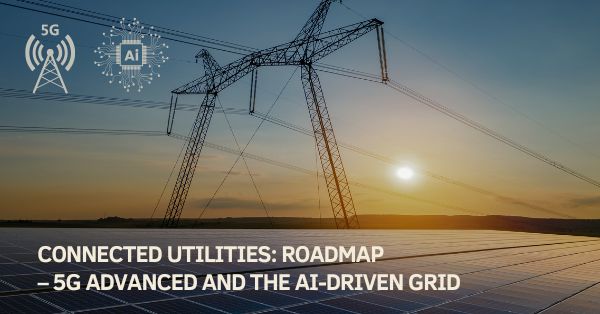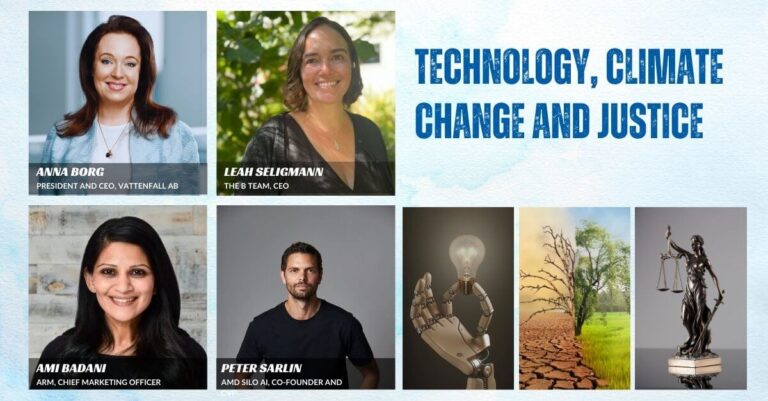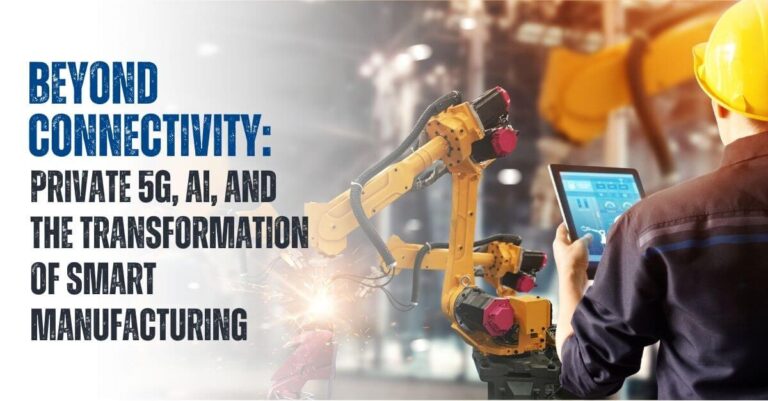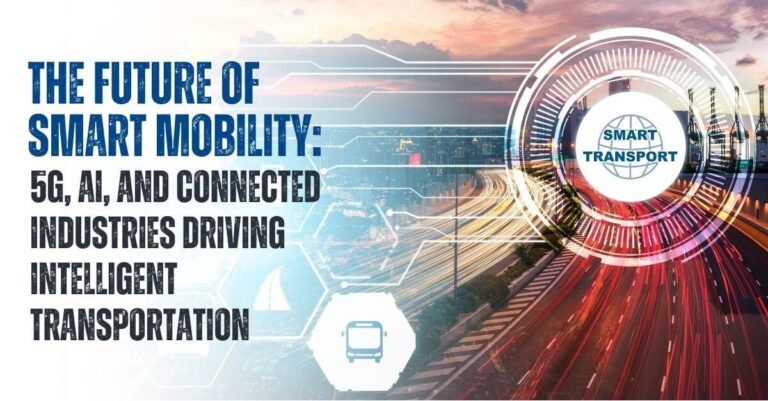As private LTE and 5G networks become operational across utility enterprises, attention is shifting toward the next phase of innovation: 5G Advanced and the AI-driven grid. This evolution marks more than a technical upgrade—it represents a paradigm shift in how utilities monitor, automate, and optimize complex distributed systems. From network programmability to predictive control, the fusion of 5G Advanced with artificial intelligence will unlock new levels of autonomy, efficiency, and grid resilience.
In this final installment of the Connected Utilities series, we explore how emerging 5G and AI capabilities are setting the stage for the utility grid of the future.
The Promise of 5G Advanced for Utility Private Networks
5G Advanced, often referred to as Release 18 and beyond, enhances baseline 5G networks with powerful new capabilities. For utilities, this means:
- Higher reliability and determinism: Built-in support for Time-Sensitive Networking (TSN), enabling ultra-reliable control for substation automation or teleprotection.
- Non-terrestrial network integration: Seamless use of satellite and aerial platforms to connect hard-to-reach assets.
- Expanded network slicing: Deeper, more customizable slicing for mission-specific needs, such as isolating smart metering traffic from protection signals or maintenance video feeds.
- Ambient IoT and RedCap support: Low-cost, low-power connectivity for millions of sensors using Reduced Capability (RedCap) devices, ideal for environmental monitoring or asset tracking.
These enhancements will make private networks even more robust, paving the way for a hyper-connected grid infrastructure that can self-adjust in real time.
AI at the Edge: Enabling Predictive and Autonomous Grids
One of the most transformative developments is the convergence of AI and edge computing within private networks. AI models deployed at substations, control centers, or mobile hubs can:
- Detect patterns in load, generation, or voltage anomalies in milliseconds
- Trigger preventive maintenance workflows before failure occurs
- Prioritize grid events and alerts through intelligent filtering
- Forecast energy usage based on historical and contextual data
As grid operations become more decentralized, edge AI reduces reliance on centralized cloud platforms, improving latency, autonomy, and resilience. AI also enhances demand response, enabling utilities to dynamically adjust consumption and generation based on grid conditions or market signals.
Utilities are beginning to train domain-specific AI models using real-world operational data. These models are embedded into edge nodes or MEC platforms, where they continuously adapt to changing conditions without compromising privacy or security. AI-driven anomaly detection, reinforcement learning for energy optimization, and generative AI models for simulating outage scenarios are emerging areas of innovation.
Composable and Programmable Utility Networks
Another defining trend is the shift toward composable and programmable infrastructure. Using software-defined networking (SDN) and network function virtualization (NFV), utilities will increasingly treat networks like software—deploying, upgrading, and tailoring services as business needs evolve.
In a composable environment, network functions such as firewalls, routing policies, or encryption modules can be deployed as microservices, configured on demand and orchestrated through APIs. This approach reduces time-to-deploy for new capabilities and allows utilities to react quickly to events like:
- Temporary expansion of coverage for emergency zones
- Reprioritization of traffic during storms or blackouts
- Onboarding of third-party applications (e.g., drone fleets or digital twins)
This model also supports energy-as-a-service offerings, where utilities can monetize parts of their network to support external partners, while maintaining secure, segregated control through slicing and policy management.
Using Digital Twins and Human-in-the-Loop for Smart Grids
Future utility operations will combine automated decision-making with human oversight. Digital twins of substations, wind farms, or grid segments will allow operators to:
- Simulate contingencies and run what-if scenarios
- Train AI models using synthetic data
- Perform remote training or certification for field engineers
These systems improve safety and reduce response time while enhancing the utility’s ability to anticipate and manage extreme events. Human-in-the-loop systems ensure transparency, accountability, and ethical decision-making, especially as AI systems take on more grid operations and safety responsibilities.
Preparing for an AI-First Utility Grid
Looking ahead, utilities will need to invest in foundational elements that support an AI-first operational model. These include:
- Digital twins of network infrastructure and assets
- Data lakes and real-time data pipelines to feed AI models
- Federated learning environments to train AI securely across sites
- AI governance frameworks to ensure ethical, compliant deployment
This transformation is not just technical—it also requires workforce upskilling, cross-functional collaboration, and alignment between IT, OT, and AI strategy teams. Success will hinge on a utility’s ability to build agile operating models that adapt quickly to both technical disruptions and policy shifts.
Challenges and Considerations for 5G Advanced and AI in Utilities
While promising, the future roadmap also brings challenges:
- Skills Gap: Utilities must invest in workforce upskilling to support AI, cloud-native platforms, and orchestration tools.
- Vendor Interoperability: Ensuring multi-vendor systems can share data and align on standards.
- AI Ethics and Governance: Establishing guidelines for responsible AI use, including bias mitigation and model transparency.
- Regulatory Alignment: Adapting rate structures and policies to accommodate dynamic services enabled by advanced networks.
To mitigate these challenges, utilities are engaging in public-private research collaborations, testbeds, and standards bodies (e.g., IEEE, 3GPP, NIST) to co-develop frameworks and best practices.
Table: Key Enablers of the AI-Driven Utility Grid
| Capability | Function | Enabled By |
|---|---|---|
| Time-Sensitive Networking (TSN) | Substation automation, ultra-reliable low latency | 5G Advanced, deterministic scheduling |
| Ambient IoT + RedCap Devices | Scalable, low-power sensing across remote grid infrastructure | 5G RedCap, Massive IoT |
| AI at the Edge | Predictive maintenance, anomaly detection, load forecasting | Edge compute, MEC, AI/ML models |
| Digital Twins | Simulation of grid scenarios, fault replication, and outage planning | Real-time data feeds, 3D modeling, AI |
| Programmable Networks | Agile deployment of network functions and partner apps | SDN/NFV, APIs, microservices |
| Network Slicing | Service separation (e.g., PTT, DER control, customer apps) | 5G Advanced slicing with QoS |
| Federated Learning | Collaborative AI model training without centralized data pooling | On-prem AI, secure data governance layers |
The Next Frontier: 5G Advanced and AI for Utilities
The convergence of 5G Advanced, edge computing, and artificial intelligence will redefine what’s possible for connected utilities. From autonomous grid operations to real-time climate adaptation, these technologies will be foundational to a more sustainable, resilient, and customer-centric energy future.
Utilities that begin preparing today—by investing in modern architecture, scalable AI models, and programmable networks—will be better positioned to lead in tomorrow’s intelligent energy ecosystem. As this Connected Utilities series has shown, private networks are no longer just communication backbones—they are the digital nervous system of the utility grid of the future.
Stay tuned for additional deep dives, deployment case studies, and sector-specific innovation spotlights as we continue to explore the evolution of connected infrastructure across energy, utilities, and critical industries.
Explore More from the Connected Utilities Series
Continue your learning journey with our full Connected Utilities blog series:
- Why Utilities Are Investing in Private Networks to Power the Digital Grid
- Strategic Use Cases for Private Networks in the Utility Sector
- Trends Accelerating Private Network Adoption in the Utility Sector
- Deployment Architectures and Spectrum Strategies for Utility Private Networks
- Edge Computing and AI for Predictive Utility Operations
- Governance and Lifecycle Management of Utility Private Networks
- Partner Ecosystems for Scaling Utility Private Networks
- Sustainability and ESG Drivers for Private Networks
- Monetization and Shared Use Models for Utility Private Networks
- Cybersecurity and Zero Trust for Utility Private Networks
- Future Roadmap – 5G Advanced and the AI-Driven Grid
Strengthen Your Utility Private Network Strategy
Assess your grid’s 5G readiness with our industry-specific tool, uncover gaps, and get clear, executive-ready insights to plan and deploy with confidence. Check Readiness & Premium Plans



























